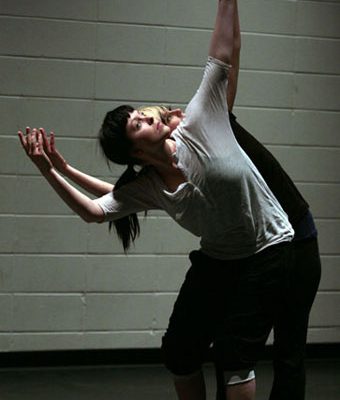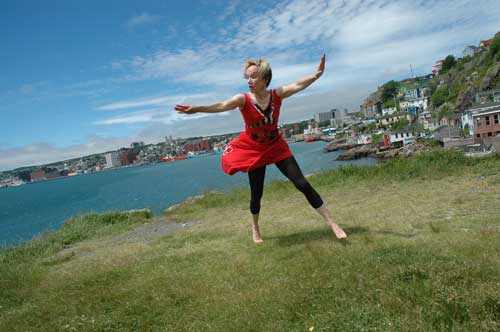Dances for a Small Stage takes place in a bar, the Crush Champagne Lounge on downtown Granville Street, just a few steps away from The Dance Centre. The bar venue is crucial to the success of the popular series, which is produced by Day Helesic and Julie-anne Saroyan of MovEnt, because having a good time is what Small Stage is all about. Modelled on the former Toronto series of the same name, the Vancouver version tends to attract good crowds for the two nights of each run, mostly a somewhat younger audience eager to sit with a few drinks and enjoy the entertainment, but with a good number of dance diehards of less tender years.
The latest edition, number twelve, followed the familiar format with an opening non-dance act (often music or comedy, this time comedy/drag), and a spectrum of dance artists, mixing experience and style in an egalitarian jumble that audiences seem to appreciate. Enthusiasm surges as time and, presumably, drinks pass, but that’s all part of the fun. Particularly for the lucky ones sitting at a proper table in the middle of the action (and with the only good sightlines of the eight-by-fifteen-foot stage), the evening is a convivial occasion. Certainly the excitement increases whenever Helesic and Saroyan manage to snare one of the dance world’s big guns.
Number twelve boasted three of these: Margie Gillis from Montréal, along with Dana Gingras of Holy Body Tattoo and Susan Elliott of Anatomica, both Vancouver-based. The chance to see the legendary, fifty-two-year-old Gillis up close led to line-ups well before the doors opened at seven on the first night, and the lounge was packed for both shows.
The performances by Gillis, Gingras and Elliott took the evening up a notch, offering an exciting level of expertise and polish. Each knows exactly what she is doing on stage, and does it brilliantly. First was Elliott, who followed Kevin Bergsma’s “I Sink I Wuv You” (the comedy/drag opener) with her familiar 1998 piece, “When a Person Enters a Structure”. It’s one of her best, moving enticingly in all directions, mostly from one spot. Like Gillis and Gingras in their pieces, Elliott touches herself a lot, pushing different parts of her body firmly forward with an energy and intention that lies well in between Gillis’ gentleness and Gingras’ violence. Elliott’s approach is cooler than either of her colleagues, which isn’t to say her work has no emotional or dramatic resonance: it does, it just slips in more quietly. The ending is sublime, with Elliott turning a few times, arms raised aloft, in a final act of grace glimpsed just as the lights go down.
Some undeveloped comedy skits followed, from Tanya Podlozniuk and Kristian Ayre, and a naughty schoolgirl piece by Amber Funk Barton, “So … you think you can highland?” Jessica Fletcher, in a plaid mini-skirt and white runners, was Barton’s highland dancer, full of attitude, eyeing the audience haughtily and propelling herself into the air with bravado.
Then came Gingras, closing the first half in a sleek black dress, her straight, shoulder-length hair Cleopatra-styled. She begins her 2004 work, “Crave #1”, by punching herself in the shoulder, motivating a movement that ends with a fall to the ground. Her body tense and ready for the worst, she thrusts and flings herself around the stage, and often onto the floor. This is not the thoughtful relationship Elliott has with choreography and the ways her body can move, but a tough battle by the moody queen of pain.
A male solo in act two came from Josh Beamish. His hip hop-influenced, contemporary jazz piece “It’s for You”, set to a danceable American band called Out Hud, was loose and lively, but too predictable. “Thought for Food”, a trio by Rob Kitsos (a faculty member at SFU) for himself, Jane Osborne and Jocelyn Wong, was definitely not predictable, and that was its strength. One minute it was all about long lines and tight trio work and the next it was humorous, as Kitsos grabbed a mic and lip-synched to the plaintive voice-over of a middle-aged, female New Yorker.
It was left to Gillis to send everyone happily home, as her “Pierre Cassé” (“Broken Stone”) closed the evening. Beautifully costumed in a dark gown with a full skirt, Gillis gave herself over to her trademark whirlpool of movement. By the end of the short solo, she swirls around the small stage in a cornucopia of curves, her long red hair falling loose from its braid, doing what she does best: dance as emotional, ecstatic release.
Gillis’ mix of strength and abandon, which was such an important feminist statement in the 1970s when she began her career, is perhaps less relevant to the millennial reality, which Gingras reflects so well. Elliott, on her part, offers a more progressive image of a woman, neither goddess nor victim, yet seducing us nonetheless with her spectacular physical commitment. Kudos to Helesic and Saroyan for enticing all three of these top Canadian artists onto their Small Stage.
Tagged: Contemporary, Performance, BC





